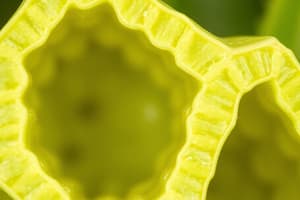Podcast
Questions and Answers
What is the primary role of plant cell walls?
What is the primary role of plant cell walls?
- Assisting in photosynthesis and energy production
- Facilitating cell communication and signaling
- Regulating water and nutrient uptake
- Providing structural support and rigidity to plants (correct)
Which of the following is NOT a component of plant cell walls?
Which of the following is NOT a component of plant cell walls?
- Starch (correct)
- Lignin
- Hemicellulose
- Cellulose
What percentage of the dry weight of plant cell walls does cellulose account for?
What percentage of the dry weight of plant cell walls does cellulose account for?
- 10-20%
- 40-50% (correct)
- 50-60%
- 20-30%
How are glucose molecules in cellulose connected to each other?
How are glucose molecules in cellulose connected to each other?
What is the primary role of hemicellulose in plant cell walls?
What is the primary role of hemicellulose in plant cell walls?
Which of the following is a significant component of pectin?
Which of the following is a significant component of pectin?
What is the role of lignin in plant cell walls?
What is the role of lignin in plant cell walls?
How do plant cell walls respond to environmental cues?
How do plant cell walls respond to environmental cues?
What is the significance of cellulose microfibrils in plant cell walls?
What is the significance of cellulose microfibrils in plant cell walls?
Which component helps cells adhere to one another within plant cell walls?
Which component helps cells adhere to one another within plant cell walls?
Flashcards are hidden until you start studying
Study Notes
Exploring the Wonders of Plant Cell Walls: An In-Depth Guide
On the vivid canvas of life, plant cell walls play a pivotal role, serving as the unsung heroes that grant rigidity, protection, and adaptability to our flora friends. In this article, we embark on a fact-rich journey through the complexity of plant cell walls, unraveling their composition, structure, and functions.
Cell Wall Basics
A cell wall is a protective, rigid layer found outside the cell membrane in both plants and certain bacteria. It's comprised of a variety of complex polysaccharides, primarily cellulose, hemicellulose, and pectin, that come together to form a strong and versatile structure.
Plant Cell Walls: A Unique Twist
While the general concept of cell walls applies to both plants and bacteria, plant cell walls carry unique characteristics that set them apart. One of the most distinctive features of plant cell walls is their composition, which is rich in cellulose microfibrils. These cellulose fibers are bundled together to form a highly flexible and strong framework, providing plants with the necessary structural support and rigidity.
Cellulose: The Backbone of Plant Cell Walls
Cellulose is a primary constituent of plant cell walls, accounting for 30-40% of their dry weight. It's a linear polymer composed of glucose molecules strung together by β-1,4-glycosidic bonds, forming long chains that can undergo hydrogen bonding. The bundling and cross-linking of cellulose microfibrils create a rigid yet flexible structure, allowing plants to maintain their shape, resist compression forces, and withstand turgor pressure.
Hemicellulose: The Sticky Component
Hemicellulose, another significant component of plant cell walls, is a heterogeneous group of polysaccharides that intertwine with cellulose microfibrils. These polysaccharides are composed of various sugar monomers like xylose, mannose, galactose, and glucose. Hemicellulose helps stabilize cellulose microfibrils, forms hydrogen bonds with cellulose, and plays a crucial role in the cell wall's flexibility and hydration.
Pectin: The Glue Holding It All Together
Pectin is a family of complex polysaccharides that serve as a "glue" within plant cell walls, allowing cells to adhere to one another. The primary components of pectin are homogalacturonan, rhamnogalacturonan I, and rhamnogalacturonan II. Pectin contributes to the cell wall's flexibility, hydration, and structural integrity, as well as its ability to respond to various environmental stimuli.
The Role of Lignin and Other Polysaccharides
While cellulose, hemicellulose, and pectin form the primary backbone of plant cell walls, other polysaccharides like chitin, xylan, and glucomannan play essential roles in plant cell wall structure, too. Lignin, a complex phenolic polymer, is mostly found in secondary cell walls and provides rigidity and structural support, particularly in woody plants.
Expanding and Responding to Environmental Cues
Plant cell walls are not static structures. They continuously expand and respond to environmental cues, such as mechanical stress, water availability, and pathogen invasion. The cell wall's flexibility and adaptability allow plants to grow, develop, and respond to their surroundings.
Concluding Thoughts
The intricate composition and structure of plant cell walls are integral to the life cycle and success of our flora friends. They provide the strength and rigidity necessary for plants to withstand various environmental stresses, while still maintaining the flexibility to grow and respond to their surroundings. As we continue to explore the secrets of plant cell walls, we uncover new insights that may help us better understand, protect, and utilize our plants for the benefit of humanity.
Studying That Suits You
Use AI to generate personalized quizzes and flashcards to suit your learning preferences.




